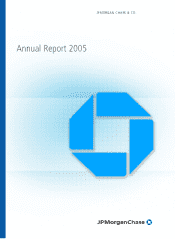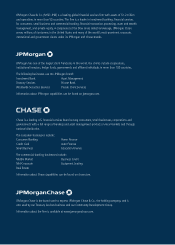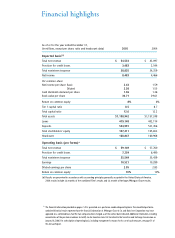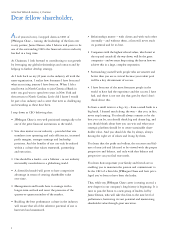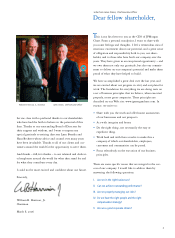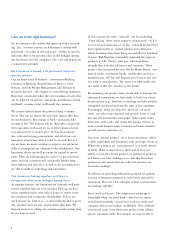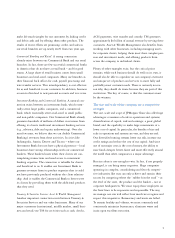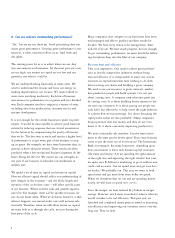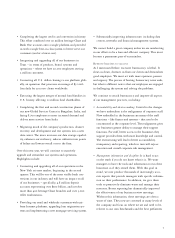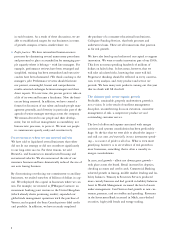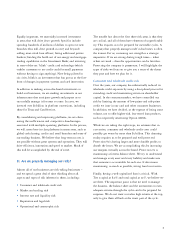JP Morgan Chase 2005 Annual Report Download - page 10
Download and view the complete annual report
Please find page 10 of the 2005 JP Morgan Chase annual report below. You can navigate through the pages in the report by either clicking on the pages listed below, or by using the keyword search tool below to find specific information within the annual report.
8
in each business. As a result of these discussions, we are
able to establish real targets for our businesses in terms
of growth, margins, returns, market share, etc.
•People practices: We have rationalized human resource
processes by eliminating several unnecessary procedures
and personnel to place accountability for managing peo-
ple squarely where it belongs – with line managers. For
example, performance reviews have been revamped and
simplified, training has been streamlined and executive
coaches have been eliminated. (We think coaching is the
manager’s job.) Performance reviews should facilitate,
not prevent, meaningful, honest and comprehensive
results-oriented exchanges between managers and their
direct reports. Yet over time, the process grew to take on
alife of its own and became a hindrance. Now the barri-
ers are being removed. In addition, we have created a
forum for discussion of our talent and made people man-
agement generally,and diversity in particular,part of the
agenda of senior manager meetings across the company.
Weremain devoted to our people and their develop-
ment, but we will use management accountability,not
bureaucratic processes, to prove it. Wewant our people
to communicate openly,easily and constructively.
Focus resources where we can succeed and win
We have sold or liquidated several businesses that either
did not fit our strategy or did not contribute significantly
to our long-term success. For these reasons, we sold
BrownCo, and businesses in manufactured housing and
recreational vehicles. We also announced the sale of our
insurance business and have dramatically reduced the size of
our auto leasing business.
By discontinuing or reducing our commitment to ancillary
businesses, we availed ourselves of billions of dollars in cap-
ital. Weredeployed this capital in businesses where we can
win. For example, we invested in JPMorgan Cazenove, an
investment banking joint venture in the United Kingdom
(which already shows promising results); expanded our
global trade management operations with the purchase of
Vastera; and acquired the Sears Canada private-label credit
card portfolio. In addition, we have recently completed
the purchase of a consumer educational loan business,
Collegiate Funding Services, that both processes and
underwrites loans. These are all transactions that position
us for real growth.
We have also freed up and redirected our capital to support
innovation. We want to make innovation part of our DNA.
This does not mean spending hundreds of millions of
dollars on failed ideas. It does mean, however, that we
will take calculated risks, knowing that some will fail.
Progressive thinking should be reflected in every conversa-
tion, every analysis, and every product and service we
provide. We have many new products coming out this year
that we think will fill this bill.
The ultimate goal: create organic growth
Profitable, sustainable, properly underwritten growth is
not a vision. It is the result of excellent management
discipline, an unrelenting focus on execution, consistent
management of risk, a competitive product set and
outstanding customer service.
The level of effort and expense associated with merger
activities and systems consolidation has been predictably
huge. So the fact that we were able to absorb the impact –
and still cut costs and materially increase investment spend-
ing – is a source of pride to all of us. What is even more
gratifying, however, is to see evidence of real growth in
most businesses, something that is often a casualty in
merger consolidations.
In ,real growth – albeit not always great growth –
took place across the board. Retail increased its deposits,
checking accounts and credit cards. Commercial Banking
achieved growth in leasing, middle market lending and lia-
bility balances. Treasury & Securities Services produced
more custody business and had growth in liability balances.
Asset & Wealth Management increased the level of assets
under management. Card Services had growth in new cus-
tomers, partners, card receivables and spending. Revenues
in the Investment Bank increased in M&A, asset-backed
securities, high-yield bonds and energy trading.

